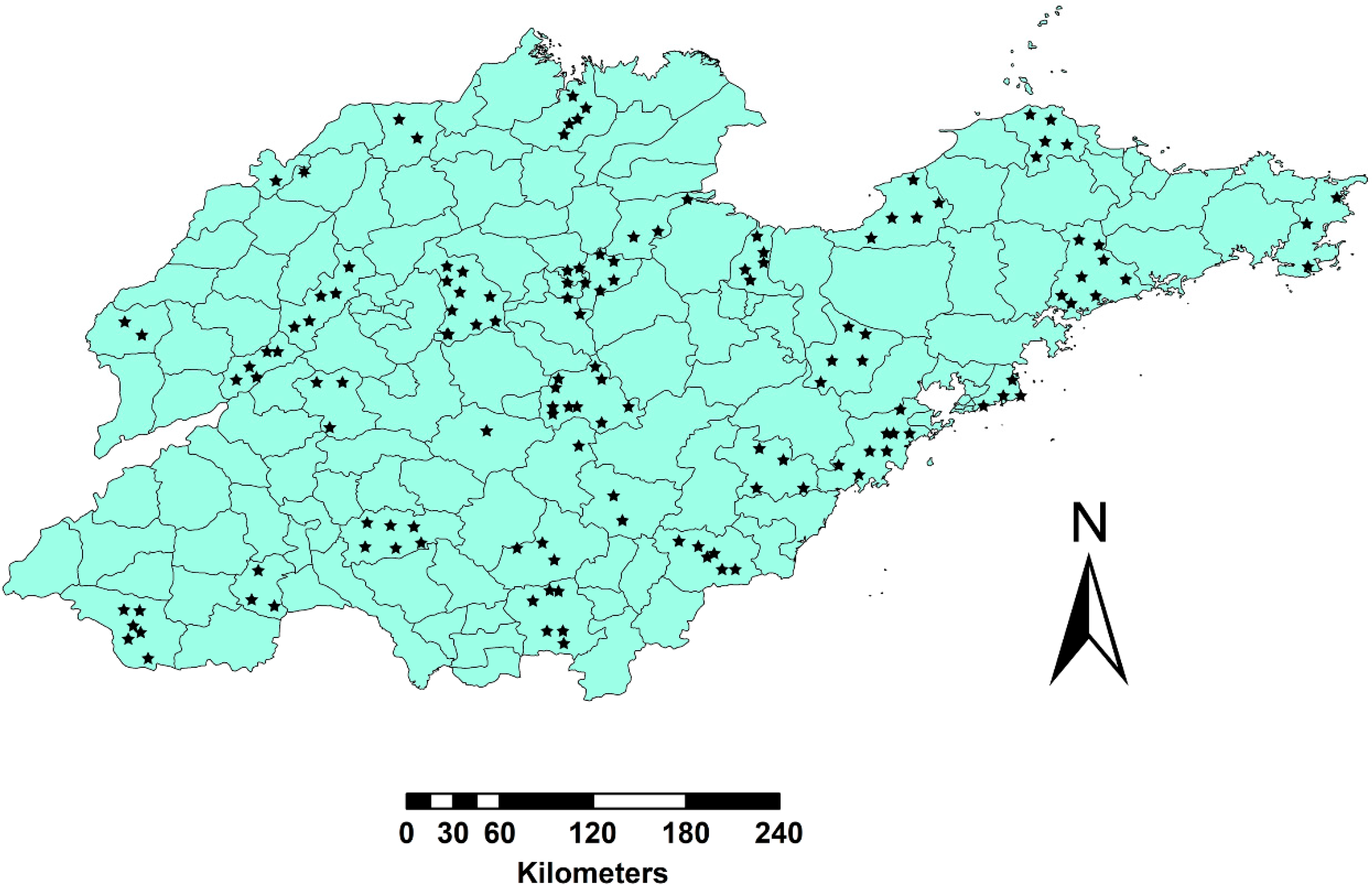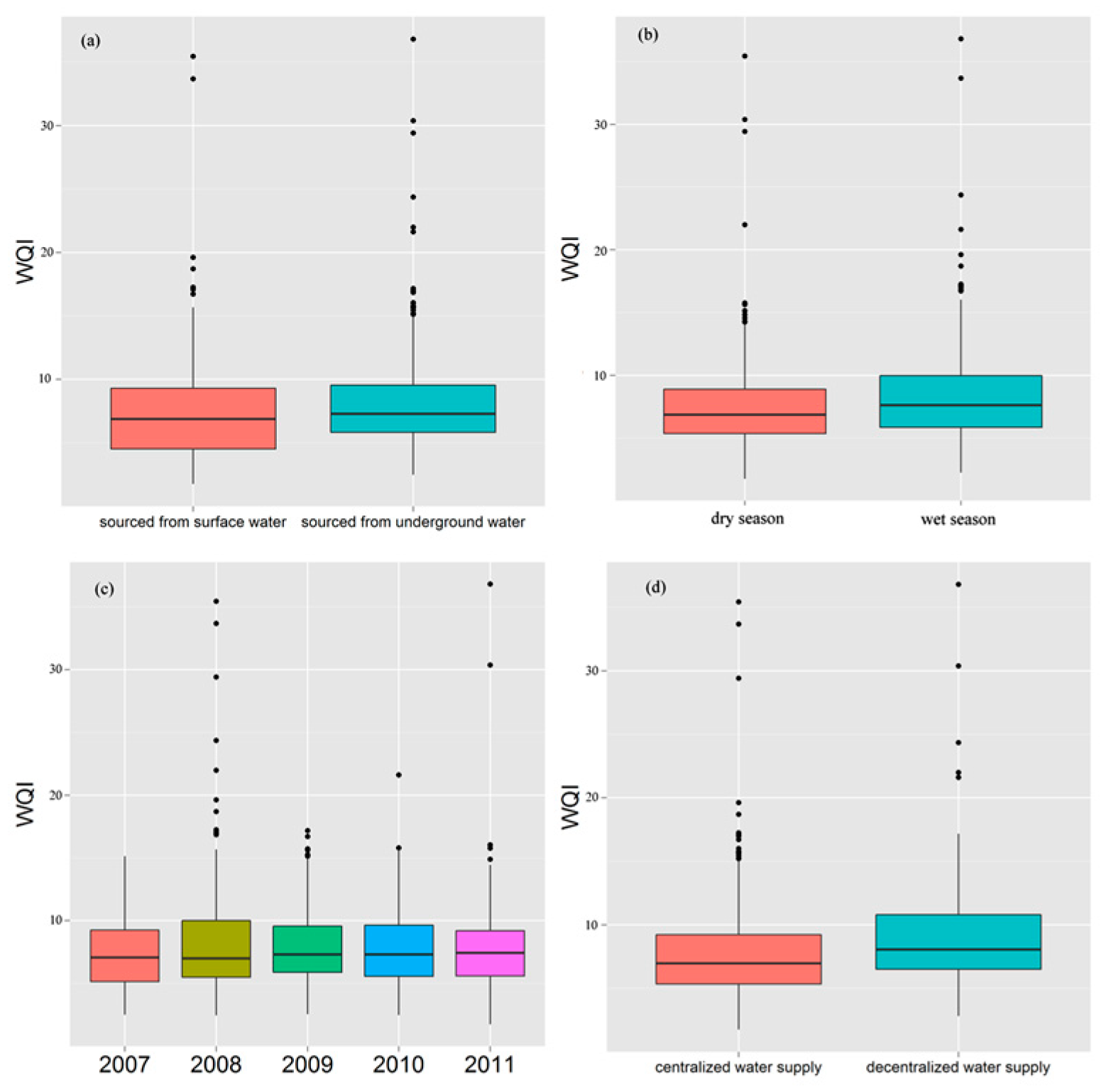Combining Spatial Analysis and a Drinking Water Quality Index to Evaluate Monitoring Data
Abstract
:1. Introduction
2. Materials and Methods
2.1. A Regional Drinking Water Quality Monitoring Plan
2.2. Spatial Temporal Assessment for WQIs
2.3. Quality Control and Data Management
3. Results
3.1. Basic Information Regarding 128 Drinking Water Quality Monitoring Points
3.2. Spatial and Temporal Distribution of WQIs
3.3. Interpolation Performance
4. Discussion
5. Conclusions
Author Contributions
Funding
Acknowledgments
Conflicts of Interest
Appendix A
| Sources | Public Water Supplies | Decentralized Water Supplies | ||||
|---|---|---|---|---|---|---|
| Treated * | Partially Treated ** | Untreated *** | Hand Pump | Dug Well | ||
| Surface water: | river | 1 | 1 | - | 0 | 1 |
| reservoir | 21 | 5 | - | 0 | 0 | |
| Groundwater: | well | - | 22 | 54 | 1 | 21 |
| spring | - | 0 | 1 | 0 | 0 | |
| Parameter | Method | Parameter | Method |
|---|---|---|---|
| Color | Eye-measurement colorimetry of platinum-cobalt color-code | Chloride | Silver nitrate volumetric method |
| Turbidity | Scattering method (Formazine standard) | Total dissolved solids | Weighing method |
| Odor | Smell method | Chemical oxygen demand (COD) | Acidic Potassium Permanganate Titration |
| pH | Glass electrode method | Fluoride | Ion-selective electrode method |
| Total hardness | EDTA titration method | Arsenic | hydride atomic fluorescence method |
| Iron | Atomic Absorption Spectrophotometry | Nitrate | Ultraviolet spectrophotometry |
| Manganese | Atomic Absorption Spectrophotometry | Total coliform bacteria (TC) | Plate counting method |
| Sulfate | Combustion-barium sulfate turbidimetry | Thermotolerant coliform bacteria (TCB) | Multi-tube Fermentation Method |
References
- Davison, A.; Howard, G.; Stevens, M.; Callan, P.; Fewtrell, L.; Deere, D.; Bartram, J.; Water, S. Water Safety Plans: Managing Drinking-Water Quality from Catchment to Consumer; World Health Organization: Geneva, Switzerland, 2005; pp. 1–12. [Google Scholar]
- Schaider, L.A.; Swetschinski, L.; Rudel, R. Environmental Justice and Drinking Water Quality in US Public Water Supplies. ISEE Conf. Abstracts 2018, 2018. [Google Scholar] [CrossRef]
- Richter, B.D.; Blount, M.E.; Bottorff, C.; Brooks, H.E.; Demmerle, A.; Gardner, B.L.; Herrmann, H.; Kremer, M.; Kuehn, T.J.; Kulow, E. Assessing the Sustainability of Urban Water Supply Systems. J. Am. Water Works Assoc. 2018, 110, 40–47. [Google Scholar] [CrossRef] [Green Version]
- World Health Organization. Guidelines for Drinking-Water Quality: Recommendations; World Health Organization: Geneva, Switzerland, 2004; pp. 28–35. [Google Scholar]
- Hounslow, A. Water Quality Data: Analysis and Interpretation; CRC Press: Boca Raton, FL, USA, 2018. [Google Scholar]
- Abbasi, T.; Abbasi, S.A. Water Quality Indices; Elsevier: Oxford, UK, 2012; pp. 15–55. [Google Scholar]
- Akter, T.; Jhohura, F.T.; Akter, F.; Chowdhury, T.R.; Mistry, S.K.; Dey, D.; Barua, M.K.; Islam, M.A.; Rahman, M. Water Quality Index for measuring drinking water quality in rural Bangladesh: A cross-sectional study. J. Health Popul. Nutr. 2016, 35, 4. [Google Scholar] [CrossRef] [PubMed]
- Othman, F.; ME, A.E.; Mohamed, I. Trend analysis of a tropical urban river water quality in Malaysia. J. Environ. Monit. 2012, 14, 3164–3173. [Google Scholar] [CrossRef]
- Damo, R.; Icka, P. Evaluation of Water Quality Index for Drinking Water. Pol. J. Environ. Stud. 2013, 22, 1045–1051. [Google Scholar]
- Ferreira, N.; Bonetti, C.; Seiffert, W. Hydrological and water quality indices as management tools in marine shrimp culture. Aquaculture 2011, 318, 425–433. [Google Scholar] [CrossRef]
- Ketata, M.; Gueddari, M.; Bouhlila, R. Use of geographical information system and water quality index to assess groundwater quality in El Khairat deep aquifer (Enfidha, Central East Tunisia). Arab. J. Geosci. 2012, 5, 1379–1390. [Google Scholar] [CrossRef]
- Rejith, P.; Jeeva, S.; Vijith, H.; Sowmya, M.; Hatha, A.M. Determination of groundwater quality index of a highland village of Kerala (India) using geographical information system. J. Environ. Health 2009, 71, 51–58. [Google Scholar]
- Fytianos, K.; Christophoridis, C. Nitrate, arsenic and chloride pollution of drinking water in Northern Greece. Elaboration by applying GIS. Environ. Monit. Assess. 2004, 93, 55–67. [Google Scholar] [CrossRef] [PubMed]
- Avery, D.C.; Smith, C.D. Access to public drinking water fountains in Berkeley, California: A geospatial analysis. BMC Public Health 2018, 18, 173. [Google Scholar] [CrossRef] [PubMed]
- Alberto, W.D.; María del Pilar, D.; María Valeria, A.; Fabiana, P.S.; Cecilia, H.A.; María de los Ángeles, B. Pattern Recognition Techniques for the Evaluation of Spatial and Temporal Variations in Water Quality. A Case Study. Water Res. 2001, 35, 2881–2894. [Google Scholar] [CrossRef]
- Singh, K.P.; Malik, A.; Mohan, D.; Sinha, S. Multivariate statistical techniques for the evaluation of spatial and temporal variations in water quality of Gomti River (India)—A case study. Water Res. 2004, 38, 3980–3992. [Google Scholar] [CrossRef] [PubMed]
- Shahid, S.U.; Iqbal, J.; Khan, S.J. A comprehensive assessment of spatial interpolation methods for the groundwater quality evaluation of Lahore, Punjab, Pakistan. NUST J. Eng. Sci. 2017, 10, 1–13. [Google Scholar]
- Beck, M.B. Water quality modeling: a review of the analysis of uncertainty. Water Resour. Res. 1987, 23, 1393–1442. [Google Scholar] [CrossRef]
- Lam, N.S.-N. Spatial interpolation methods: a review. Am. Cartogr. 1983, 10, 129–150. [Google Scholar] [CrossRef]
- Oliver, M.A.; Webster, R. Kriging: A method of interpolation for geographical information systems. Int. J. Geogr. Inf. Syst. 1990, 4, 313–332. [Google Scholar] [CrossRef]
- Van Beers, W.C.; Kleijnen, J.P.C. Kriging for interpolation in random simulation. J. Oper. Res. Soc. 2003, 54, 255–262. [Google Scholar] [CrossRef] [Green Version]
- Le, N.D.; Zidek, J.V. Interpolation with uncertain spatial covariances: a Bayesian alternative to kriging. J. Multivar. Anal. 1992, 43, 351–374. [Google Scholar] [CrossRef]
- Tomczak, M. Spatial interpolation and its uncertainty using automated anisotropic inverse distance weighting (IDW)-cross-validation/jackknife approach. J. Geogr. Inf. Decis. Anal. 1998, 2, 18–30. [Google Scholar]
- Chai, T.; Draxler, R.R. Root mean square error (RMSE) or mean absolute error (MAE)? Arguments against avoiding RMSE in the literature. Geosci. Model Dev. 2014, 7, 1247–1250. [Google Scholar] [CrossRef]
- Chen, C.; Twycross, J.; Garibaldi, J.M. A new accuracy measure based on bounded relative error for time series forecasting. PLoS ONE 2017, 12, e0174202. [Google Scholar] [CrossRef] [PubMed]
- Ministry of Health of China; China National Standardization Committee. Standard Examination Methods for Drinking Water (GB5750-2006); China Standard Press: Beijing, China, 2007; pp. 39–446.
- Bivand, R.S.; Pebesma, E.; Gómez-Rubio, V. Applied Spatial Data Analysis with R; Springer: New York, NY, USA, 2013; ISBN 978-1-4614-7617-7. [Google Scholar]
- Li, H.; Cohen, A.; Li, Z.; Zhang, M. The Impacts of Socioeconomic Development on Rural Drinking Water Safety in China: A Provincial-Level Comparative Analysis. Sustainability 2019, 11, 85. [Google Scholar] [CrossRef]
- UN Goal 6. Sustainable Development Knowledge Platform. Available online: https://sustainabledevelopment.un.org/sdg6 (accessed on 14 November 2018).
- UNICEF. Multiple Indicator Cluster Survey (MICS). Available online: https://www.unicef.org/statistics/index_24302.html (accessed on 14 November 2018).
- Khadse, G.K.; Kalita, M.; Pimpalkar, S.N.; Labhsetwar, P.K. Drinking water quality monitoring and surveillance for safe water supply in Gangtok, India. Environ. Monit. Assess. 2011, 178, 401–414. [Google Scholar] [CrossRef] [PubMed]
- Edition, F. Guidelines for drinking-water quality. WHO Chron. 2011, 38, 104–108. [Google Scholar]
- Ailamaki, A.; Faloutos, C.; Fischbeck, P.S.; Small, M.J.; VanBriesen, J. An environmental sensor network to determine drinking water quality and security. ACM Sigmod Rec. 2003, 32, 47–52. [Google Scholar] [CrossRef]
- Ward, R.C.; Loftis, J.C.; McBride, G.B. The “data-rich but information-poor” syndrome in water quality monitoring. Environ. Manag. 1986, 10, 291–297. [Google Scholar] [CrossRef]
- Jones, R.M.; Graber, J.M.; Anderson, R.; Rockne, K.; Turyk, M.; Stayner, L.T. Community drinking water quality monitoring data: utility for public health research and practice. J. Public Health Manag. Pr. 2014, 20, 210–219. [Google Scholar] [CrossRef]
- Kovács, J.; Tanos, P.; Korponai, J.; Kovácsné Székely, I.; Gondár, K.; Hatvani, I.G. Analysis of water quality data for scientists. In Water Quality Monitoring and Assessment; Intech Open: Rijeka, Croatia, 2012; pp. 65–94. [Google Scholar]
- Horton, R.K. An index number system for rating water quality. J. Water Pollut. Control Fed. 1965, 37, 300–306. [Google Scholar]
- El-Shaarawi, A.H.; Kwiatkowski, R.E. Statistical Aspects of Water Quality Monitoring; Elsevier Science: Amsterdam, The Netherlands, 2011; Volume 27. [Google Scholar]



| Year | Sources | Water Supply Types | Seasons | |||
|---|---|---|---|---|---|---|
| Groundwater | Surface Water | Centralized | Decentralized | Dry | Wet | |
| 2007 | 182 | 74 | 182 | 74 | 128 | 128 |
| 2008 | 208 | 48 | 196 | 60 | 128 | 128 |
| 2009 | 204 | 52 | 206 | 50 | 128 | 128 |
| 2010 | 202 | 54 | 208 | 48 | 128 | 128 |
| 2011 | 202 | 54 | 208 | 48 | 128 | 128 |
© 2019 by the authors. Licensee MDPI, Basel, Switzerland. This article is an open access article distributed under the terms and conditions of the Creative Commons Attribution (CC BY) license (http://creativecommons.org/licenses/by/4.0/).
Share and Cite
Li, H.; Smith, C.D.; Wang, L.; Li, Z.; Xiong, C.; Zhang, R. Combining Spatial Analysis and a Drinking Water Quality Index to Evaluate Monitoring Data. Int. J. Environ. Res. Public Health 2019, 16, 357. https://doi.org/10.3390/ijerph16030357
Li H, Smith CD, Wang L, Li Z, Xiong C, Zhang R. Combining Spatial Analysis and a Drinking Water Quality Index to Evaluate Monitoring Data. International Journal of Environmental Research and Public Health. 2019; 16(3):357. https://doi.org/10.3390/ijerph16030357
Chicago/Turabian StyleLi, Hongxing, Charlotte D. Smith, Li Wang, Zheng Li, Chuanlong Xiong, and Rong Zhang. 2019. "Combining Spatial Analysis and a Drinking Water Quality Index to Evaluate Monitoring Data" International Journal of Environmental Research and Public Health 16, no. 3: 357. https://doi.org/10.3390/ijerph16030357





